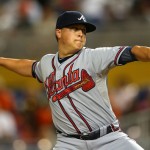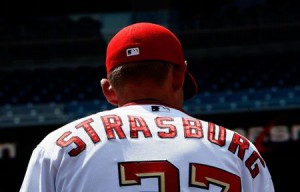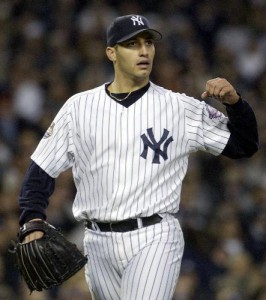Now that the playoff fields are set … who has the most formidable playoff rotation?
Unlike previous rotation rankings posts, the playoffs focus mostly on the 1-2-3 guys. Your 5th starter may not even be on the playoff roster and your 4th starter usually just throws one start in a series where you can line up your guys, and some teams skip the 4th starter altogether if they at least one veteran pitcher who can all go on 3 days rest (there’s enough off-days in the 2-3-2 format to allow most guys to go on regular rest). So the focus here is on the strength of your top guys.
Here’s how I’d rank the 10 playoff teams’ rotations, despite the fact that two of these teams will be wild card losers and never get a chance to use their rotations:
- Los Angeles: Kershaw, Greinke, Nolasco, Ryu (Capuano left out). As great a 1-2 combination Kershaw and Greinke are, Nolasco has for stretches outpiched them both since his trade, and Ryu is a #2 starter talent in the #4 slot. They’re going to be a tough out in any short series where Kershaw gets two starts. Easily the #1 playoff rotation.
- Detroit: Scherzer, Verlander, Sanchez, Fister (Porcello left out). Hard to believe that a guy who most thought was the best or 2nd best pitcher in baseball (Verlander) may not even get the start in the first game of the playoffs. But they’re still the 2nd best rotation.
- St. Louis: Wainwright, Miller, Wacha, Kelly (Westbrook and Garcia hurt, Lynn left out). The knock on St Louis’ current rotation is their youth; two rookies and a 2nd year guy who was in the bullpen all last year. Are there any innings-limit concerns here that could force a shutdown It doesn’t seem so at this point? It continues to amaze me how well St. Louis develops players. Carpenter and Garcia out all year? No worries we’ll just bring up two guys in Wacha and Miller who are barely old enough to drink but who can pitch to a 120 ERA+.
- Tampa Bay: Price, Moore, Archer, Cobb (Hellickson left out); A tough top 4, if a little young on the back-side. Moore has quietly returned to this dominant form upon his call-up and gives Tampa a formidable 1-2 punch. Price has already pushed them past game 163.
- Pittsburgh: Liriano, Burnett, Cole, Morton (Rodriguez hurt, Locke left out). The team previously said that Cole would likely a reliever in the playoffs, but I’ll believe that when I see it; he’s been fantastic down the stretch. It is difficult to put a rotation headlined by the burnout Burnett and the reclamation project Liriano this high, but their performances this year are inarguable.
- Boston: Lester, Buchholz, Peavy, Lackey (Dempster, Doubront left out). Buchholz just returning mid September after a hot start; could push this rank up. I don’t necessarily trust the #3 and #4 spots here in a short series, but Boston can (and probably will) bash their way to the World Series.
- Cincinnati: Bailey, Cueto, Arroyo, Cingrani (Leake left out, Latos hurt). Cingrani may be hurt, Cueto has returned to replace the sore-armed Latos. Leake’s performance may push him over Arroyo if they get there, but the odds of them beating Pittsburgh were already slim after their poor finish and were vanquished last night. Still, isn’t it nice when you have more quality starters than you need heading into a season, Mike Rizzo?
- Atlanta: Minor, Medlen, Teheran, Wood (Hudson hurt, Maholm left out). If Wood is shutdown, Maholm makes sense as the #4 starter but has struggled most of the 2nd half and finished poorly. I may have this rotation ranked too low; they’re solid up and down, just not overpoweringly flashy.
- Cleveland: Jimenez, Kluber, Kazmir, Salazar (Masterson in the pen, McAllister left out). How did these guys get a playoff spot? Amazing. They’re all solid, nobody especially flashy, and they won’t go away.
- Oakland: Colon, Parker, Griffen, Gray (Milone, Straily left out, Anderson in long relief). I didn’t want to rank them last, considering Oakland’s record over their last 162 game stretch. But here they are; on an individual level one by one, they just do not stack up. The age-less wonder Colon is easily the staff Ace. The rest of these guys’ seasonal numbers are just not impressive.
These teams obviously didn’t make the playoffs, but were in the hunt until late, and since I had already typed up this content might as well say where I’d have ranked them, had they made the playoffs…
- Washington: Strasburg, Gonzalez, Zimmermann, Haren (Ohlendorf, Roark left out, Jordan shut down) Perhaps you’d replace Haren with Roark based on September performances; I just can’t imagine trusting Haren in a 7 game series.. I’d put them about #4, just ahead or just behind Tampa. Gonzalez and Zimmermann have shown themselves to be oddly vulnerable here and there coming down the stretch, and I just don’t put Strasburg in the same elite category as Kershaw right now. Too bad months of indifference cost them the 4 games they needed to make up in the standings to reach the WC game.
- Kansas City: Shields, Santana, Chen, Guthrie (Duffy, Davis, Mendoza left out): Duffy may be a better choice than Guthrie based on small sample sizes. I’d have put them just behind Cincy at #8 in terms of rotation depth.
- Texas: Darvish, Garza, Holland, Perez (Tepisch, Grimm left out, Harrison hurt): Great Ace in Darvish (even if he has occasaional blowups), but falls off badly after that. The Garza acquisition has just not worked out, and the rest of the rotation is good but not overpowering. I’d put them behind KC but just ahead of Baltimore.
- Baltimore: Tillman, Chen, Gonzalez, Feldman (Norris, Garcia, Hammel and others left out). They’d probably be behind Atlanta at #9, only ahead of Oakland/Cleveland.
- New York: Sabathia, Kuroda, Nova, Pettitte (Hughes, Phelps left out): Kuroda has been the ace of the staff this year, but you’d always lead off with Sabathia (though, had they made the playoffs it would be unknown if Sabathia could even go with his late-season injury). Either way, this would be behind any other playoff team’s rotation.




